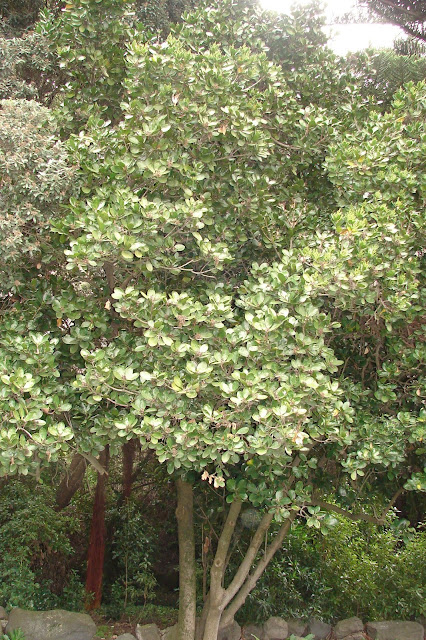Corynocarpus laevigatus, karaka or kopi is endemic, but exact indigenous distribution uncertain due to its widespread historic planting by Maori. It is common from Raoul and the Three Kings Islands, throughout the North and South Islands to Banks Peninsula and Okarito, and is also on the Chatham Islands. Most botanists accept it as native only to the northern half of the North Island. It is probably naturalised from deliberate Polynesian plantings on Raoul and the Chatham Islands. It is common in mainly coastal situations, often a major component of coastal forest, but rarely dominant. Occasionally found inland, and then often in association with Maori cultural deposits. Karaka is a very distinctive tree up to 15m tall, that is unlikely to be confused with any other indigenous, naturalised or planted exotic tree. The simply, leathery, dark green leaves and large orange drupes with their fibrous endocarp serve to immediately distinguish it. Some Botanic Gardens hold specimens of the other 4 species of the genus, vegetatively these look similar to karaka but their fruits are very different in colour, shape and size. It flowers from August – November followed by large orange drupes. January to April. The pulp of the fruit is edible, although bitter, but the kernel of the fruit should be treated as deadly poison because the fresh kernels of the species contain a lethal toxin Karakin, and so the species has been banned from some amenity plantings and day care and kindergartens. The toxin, an alkaloid breaks down with exposure to UV light. Accounts from the 19th century record that extensive processing was used by Māori to convert the kernels to an edible form, and mention that if the processing was not done with the greatest care, poisoning would result with symptoms including violent convulsions and severe muscle spasms which could leave the limbs permanently fixed in contorted positions. Death resulted in a few cases. Considered frost sensitive and is best grown in coastal conditions in Christchurch. It suits a sunny site, rich deep soil, well drained and adequate moisture. It is abundant and not threatened, often naturalising in suitable habitats. A serious pest in the Hawaian Islands.
Tuesday, 29 January 2019
Subscribe to:
Post Comments (Atom)
Leptinella squalida subsp. mediana is endemic to the South and Stewart Islands. It is found from northwest Nelson and inland Marlborough to...

-
Olearia odorata or scented tree daisy is endemic to the South Island. Its is found in lowland and montane shrubland and scrub, in the easter...
-
Dacrydium cupressinum, rimu or red pine is endemic to the North, South and Stewart Islands - uncommon in large parts of the eastern South Is...
-
Clematis 'Purity’ is a cultivar of Clematis fosterii and Clematis paniculata, that was bred by the late Mr Arthur Ericson of Akaroa for...






No comments:
Post a Comment